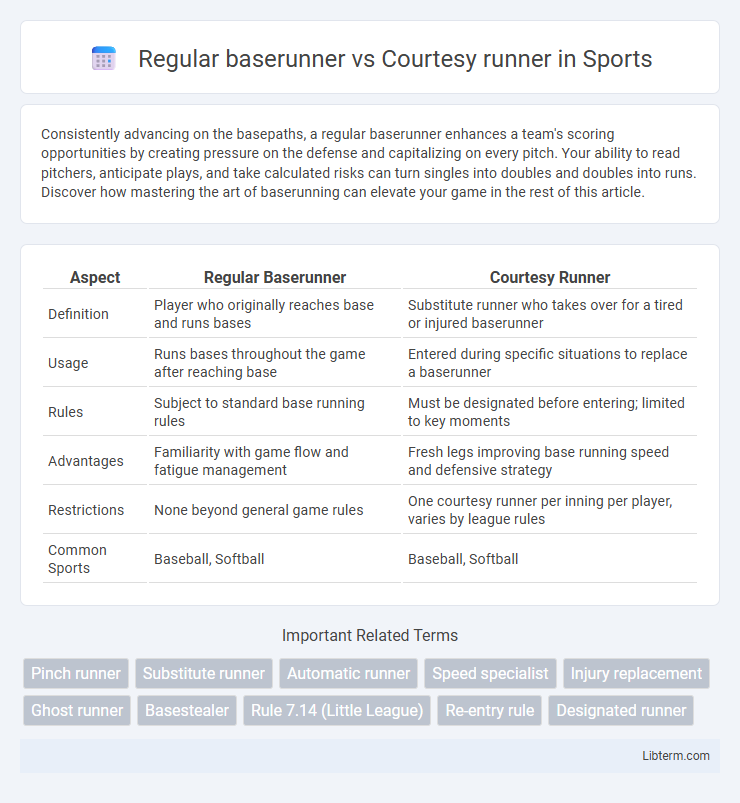Consistently advancing on the basepaths, a regular baserunner enhances a team's scoring opportunities by creating pressure on the defense and capitalizing on every pitch. Your ability to read pitchers, anticipate plays, and take calculated risks can turn singles into doubles and doubles into runs. Discover how mastering the art of baserunning can elevate your game in the rest of this article.
Table of Comparison
| Aspect | Regular Baserunner | Courtesy Runner |
|---|---|---|
| Definition | Player who originally reaches base and runs bases | Substitute runner who takes over for a tired or injured baserunner |
| Usage | Runs bases throughout the game after reaching base | Entered during specific situations to replace a baserunner |
| Rules | Subject to standard base running rules | Must be designated before entering; limited to key moments |
| Advantages | Familiarity with game flow and fatigue management | Fresh legs improving base running speed and defensive strategy |
| Restrictions | None beyond general game rules | One courtesy runner per inning per player, varies by league rules |
| Common Sports | Baseball, Softball | Baseball, Softball |
Understanding Regular Baserunners
Regular baserunners maintain their position on the base path while actively attempting to advance during live play, relying on speed, awareness, and strategic decision-making to evade tags and maximize scoring opportunities. Unlike courtesy runners, who substitute temporarily to preserve player stamina or expedite play, regular baserunners participate continuously and remain essential for maintaining offensive momentum. Mastery of leads, jumps, and reading pitchers defines the skill set crucial to effective regular baserunning in competitive baseball and softball.
Defining a Courtesy Runner
A courtesy runner is a designated player who replaces a baserunner temporarily to improve the team's chances of scoring or advancing bases, often used in informal or recreational baseball leagues. Unlike a regular baserunner who remains on base throughout the play, the courtesy runner only runs in place of the original player during that specific instance and is then substituted back. This rule helps maintain game pace and player safety by allowing rested or faster players to avoid unnecessary fatigue or injury.
Key Differences Between Regular and Courtesy Runners
Regular baserunners actively run the bases after hitting the ball or following a teammate's action, maintaining their original role throughout the game, while courtesy runners are substitutes who specifically run for another player to preserve energy or prevent injury. Courtesy runners are typically employed in crucial game situations to enhance team performance without changing the batting order, whereas regular baserunners are part of the standard offensive play. The key difference lies in intent and usage: regular baserunners participate continuously, whereas courtesy runners are strategically inserted for short-term physical relief.
Situational Uses for Courtesy Runners
Courtesy runners are strategically deployed in baseball to maintain offensive momentum during high-pressure situations such as late innings, injury replacements, or fatigue management. Regular baserunners rely on their own skills for speed and base stealing, whereas courtesy runners enter the game to minimize risk and preserve scoring opportunities without altering the defensive lineup. Teams often utilize courtesy runners during crucial moments like extra innings, tight scorelines, or when a key hitter is scheduled to bat next, ensuring optimal performance without compromising overall game strategy.
Eligibility Rules for Courtesy Runners
Eligibility rules for courtesy runners specify that the substitute must be a player not currently in the game and generally limited to one per inning per team to maintain fairness. Regular baserunners are original players who reached base through hitting or walking, while courtesy runners are used solely to replace them temporarily or permanently due to injury or strategic reasons. The courtesy runner's eligibility is closely tied to official league rules, often requiring confirmation by the umpire to prevent abuse of substitution advantages.
Impact on Game Strategy
Regular baserunners provide consistent decision-making and speed adaptability, crucial for strategic plays like stealing bases or advancing on fly balls. Courtesy runners offer immediate speed replacement without player fatigue, allowing managers to optimize late-game tactics and maintain defensive lineup integrity. Utilizing courtesy runners strategically can shift momentum by enhancing base-stealing threats and putting pressure on opposing pitchers.
Common Scenarios for a Courtesy Runner
Courtesy runners are commonly used in baseball during late innings when a player is injured, fatigued, or needs to preserve energy for upcoming plays. Managers often insert courtesy runners for catchers or pitchers who are slower but vital defensively, ensuring quicker baserunning without compromising team strength. This strategy balances competitive advantage and player health while adhering to league rules on substitutions.
Advantages of Using a Courtesy Runner
Using a courtesy runner in baseball maximizes team efficiency by allowing a fresh, faster player to advance bases without risking fatigue or injury to the regular baserunner. This strategy enhances scoring opportunities, particularly in late innings or critical game situations, by increasing the likelihood of successful stolen bases or runs scored. Coaches leverage courtesy runners to maintain defensive readiness and capitalize on optimal speed without compromising the original player's performance.
Controversies Surrounding Courtesy Runners
Courtesy runners, often used to speed up play or replace injured baserunners, have sparked debate regarding fairness and game integrity in professional baseball. Critics argue courtesy runners can disrupt the natural flow and strategy, giving some teams an unfair advantage by substituting faster or more skilled players mid-inning without penalty. Controversies also arise over inconsistent application of courtesy runner rules across leagues, leading to confusion and disputes during critical game moments.
Summary: Choosing Between Regular and Courtesy Runners
Regular baserunners maintain their position throughout the game, relying on endurance and strategic awareness to advance bases, whereas courtesy runners are substituted specifically to speed up base running without replacing the original player permanently. The decision to use a courtesy runner depends on game context, player fatigue, and the need for speed in critical situations. Coaches prioritize courtesy runners when quick base advancement is crucial, balancing the risk of substitution limitations with the potential for scoring advantages.
Regular baserunner Infographic

 libterm.com
libterm.com